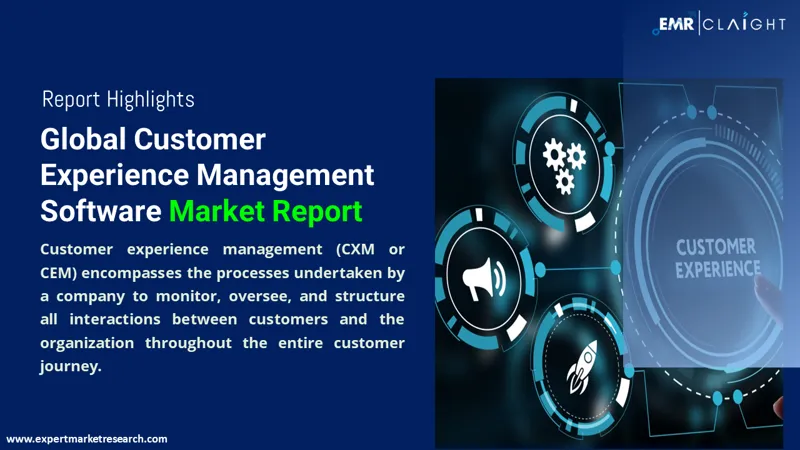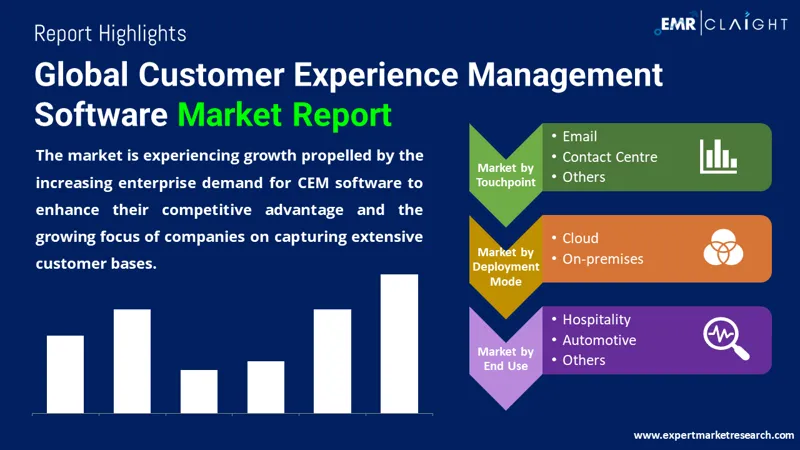
Consumer Insights
Uncover trends and behaviors shaping consumer choices today
Procurement Insights
Optimize your sourcing strategy with key market data
Industry Stats
Stay ahead with the latest trends and market analysis.
The global customer experience management software market size reached approximately USD 14.39 Billion in 2025. The market is projected to grow at a CAGR of 14.40% between 2026 and 2035, reaching a value of around USD 55.25 Billion by 2035.
Base Year
Historical Period
Forecast Period
Compound Annual Growth Rate
14.4%
Value in USD Billion
2026-2035
*this image is indicative*
| Global Customer Experience Management Software Market Report Summary | Description | Value |
| Base Year | USD Billion | 2025 |
| Historical Period | USD Billion | 2019-2025 |
| Forecast Period | USD Billion | 2026-2035 |
| Market Size 2025 | USD Billion | 14.39 |
| Market Size 2035 | USD Billion | 55.25 |
| CAGR 2019-2025 | Percentage | XX% |
| CAGR 2026-2035 | Percentage | 14.40% |
| CAGR 2026-2035 - Market by Region | Asia Pacific | 18.6% |
| CAGR 2026-2035 - Market by Country | India | 21.4% |
| CAGR 2026-2035 - Market by Country | China | 17.9% |
| CAGR 2026-2035 - Market by Touchpoint | Social Media | 16.3% |
| CAGR 2026-2035 - Market by Deployment Mode | Cloud | 15.8% |
| Market Share by Country 2025 | Australia | 2.3% |
Customer experience management, also known as CXM or CEM, refers to the set of procedures employed by a company to monitor, supervise, and structure all engagements between a customer and the organisation across the entire customer journey. However, a different software, known as customer relationship management software, is utilised as a tool to encompass all touchpoints and understand, manage, and improve the customer experience.

Read more about this report - REQUEST FREE SAMPLE COPY IN PDF

Read more about this report - REQUEST FREE SAMPLE COPY IN PDF
The EMR’s report titled “Customer Experience Management Software Market Report and Forecast 2026-2035" offers a detailed analysis of the market based on the following segments:
Market Breakup by Touchpoint
Market Breakup by Deployment Mode
Market Breakup by End Use
Market Breakup by Region
During the forecast period, the on-premises segment is expected to experience significant growth. Numerous companies are transitioning from manual systems to automated systems to streamline their operations. Moreover, the demand for on-premises customer experience management solutions is expected to surge among large enterprises due to the growing emphasis on data privacy.
Call centres are anticipated to hold a major portion of the customer experience management software market share. This can be attributed to the growing inclination towards advanced contact centre technologies, leading to an increased adoption of customer experience management software.
Furthermore, the deployment of cloud-based and virtual contact centre solutions is on the rise, contributing to the segment's expansion. Businesses are also actively focusing on enhancing customer interactions to achieve higher levels of customer satisfaction, thereby reinforcing the requirement for CEM software in call centres.
| CAGR 2026-2035 - Market by | Country |
| India | 21.4% |
| China | 17.9% |
| Saudi Arabia | 16.4% |
| Mexico | 13.4% |
| USA | 11.7% |
| Canada | XX% |
| UK | XX% |
| Germany | 10.6% |
| Italy | XX% |
| Japan | XX% |
| Australia | XX% |
| Brazil | XX% |
| France | 10.1% |
The comprehensive EMR report provides an in-depth assessment of the market based on Porter's five forces model along with giving a SWOT analysis. The report gives a detailed analysis of the following key players in the global customer experience management software market, covering their competitive landscape and the latest developments like mergers, acquisitions, investments and expansion plans.
Adobe Inc. is one of the global leaders in the software development sector. It was founded in 1982 and has developed multiple software applications for digital media and digital marketing applications. One of the company’s most widely known software includes Adobe Photoshop, a powerful image editing software widely used by photographers, graphic designers, and artists.
IBM Corporation, also known as The International Business Machine Corporation, is a global leader and one of the most influential software companies in the world. The company was founded in 1911 and it is currently headquartered in New York, the United States. IBM is known for its mainframe computers, which are powerful and highly reliable machines used by large enterprises and organisations for critical applications.
Oracle Corporation is one of the largest multinational computer technology corporations based in California, the United States. Since its establishment in 1977, the company has developed multiple software and technologies, as well as enterprise software to cater to various business functions such as finance, human resources, supply chain management, customer experience, and more.
*Please note that this is only a partial list; the complete list of key players is available in the full report. Additionally, the list of key players can be customized to better suit your needs.*
Other market players include Avaya Holdings Corp, NICE Ltd., SAP SE, Verint Systems Inc., Open Text Corporation, Tech Mahindra Limited, Teradata Corporation, and Sprinklr, Inc., among others.




*While we strive to always give you current and accurate information, the numbers depicted on the website are indicative and may differ from the actual numbers in the main report. At Expert Market Research, we aim to bring you the latest insights and trends in the market. Using our analyses and forecasts, stakeholders can understand the market dynamics, navigate challenges, and capitalize on opportunities to make data-driven strategic decisions.*
Get in touch with us for a customized solution tailored to your unique requirements and save upto 35%!
In 2025, the market reached a value of about USD 14.39 Billion.
The market is projected to grow at a CAGR of 14.40% between 2026 and 2035.
The market is estimated to witness a healthy growth in the forecast period of 2026-2035 to reach around USD 55.25 Billion by 2035.
The market growth is being driven by the rising demand for CEM software among enterprises to boost their competitive edge and the increasing efforts of companies to capture large customer bases.
The key trends propelling the market growth include the rising implementation of artificial intelligence and automation and the growing shift towards cloud technologies.
The major regional markets include North America, Europe, the Asia Pacific, Latin America, and the Middle East and Africa.
The different segments based on the touchpoint of the product are the web, social media, email, and contact centres, among others.
The key players in the customer experience management software market include Adobe Inc., IBM Corporation, Oracle Corporation, Avaya Holdings Corp, NICE Ltd., SAP SE, Verint Systems Inc., Open Text Corporation, Tech Mahindra Limited, Teradata Corporation, and Sprinklr, Inc., among others.
Explore our key highlights of the report and gain a concise overview of key findings, trends, and actionable insights that will empower your strategic decisions.
| REPORT FEATURES | DETAILS |
| Base Year | 2025 |
| Historical Period | 2019-2025 |
| Forecast Period | 2026-2035 |
| Scope of the Report |
Historical and Forecast Trends, Industry Drivers and Constraints, Historical and Forecast Market Analysis by Segment:
|
| Breakup by Touchpoint |
|
| Breakup by Deployment Mode |
|
| Breakup by End Use |
|
| Breakup by Region |
|
| Market Dynamics |
|
| Competitive Landscape |
|
| Companies Covered |
|
Datasheet
One User
USD 2,499
USD 2,249
tax inclusive*
Single User License
One User
USD 3,999
USD 3,599
tax inclusive*
Five User License
Five User
USD 4,999
USD 4,249
tax inclusive*
Corporate License
Unlimited Users
USD 5,999
USD 5,099
tax inclusive*
*Please note that the prices mentioned below are starting prices for each bundle type. Kindly contact our team for further details.*
Flash Bundle
Small Business Bundle
Growth Bundle
Enterprise Bundle
*Please note that the prices mentioned below are starting prices for each bundle type. Kindly contact our team for further details.*
Flash Bundle
Number of Reports: 3
20%
tax inclusive*
Small Business Bundle
Number of Reports: 5
25%
tax inclusive*
Growth Bundle
Number of Reports: 8
30%
tax inclusive*
Enterprise Bundle
Number of Reports: 10
35%
tax inclusive*
How To Order

Select License Type
Choose the right license for your needs and access rights.

Click on ‘Buy Now’
Add the report to your cart with one click and proceed to register.

Select Mode of Payment
Choose a payment option for a secure checkout. You will be redirected accordingly.
Gain insights to stay ahead and seize opportunities.

Get insights & trends for a competitive edge.

Track prices with detailed trend reports.

Analyse trade data for supply chain insights.

Leverage cost reports for smart savings

Enhance supply chain with partnerships.

Connect For More Information
Our expert team of analysts will offer full support and resolve any queries regarding the report, before and after the purchase.
Our expert team of analysts will offer full support and resolve any queries regarding the report, before and after the purchase.
We employ meticulous research methods, blending advanced analytics and expert insights to deliver accurate, actionable industry intelligence, staying ahead of competitors.
Our skilled analysts offer unparalleled competitive advantage with detailed insights on current and emerging markets, ensuring your strategic edge.
We offer an in-depth yet simplified presentation of industry insights and analysis to meet your specific requirements effectively.
Share